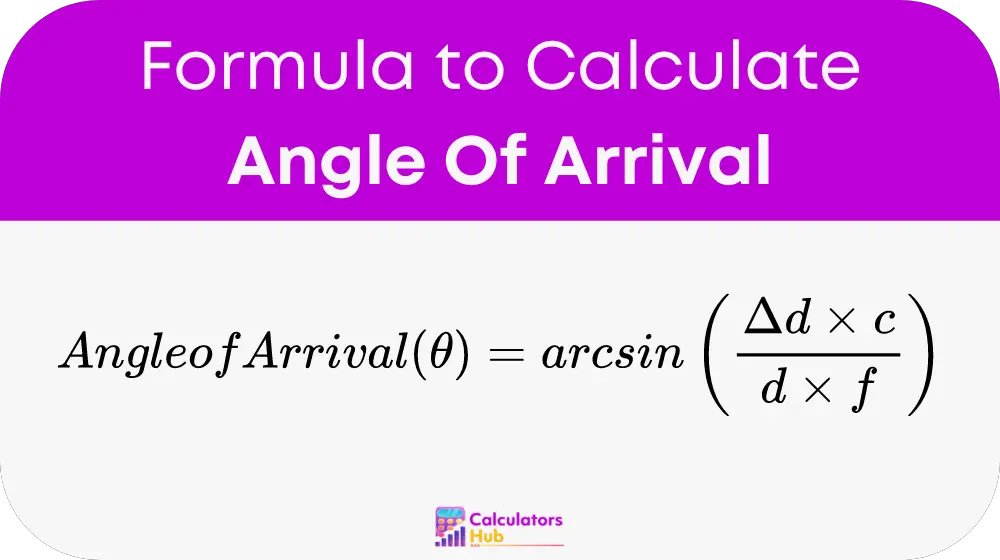The Angle of Arrival (AoA) Calculator is a specialized tool used in telecommunications and signal processing to determine the direction from which a signal arrives at a receiving antenna array. This tool is essential in applications such as radar, sonar, and wireless communications, where accurately identifying the signal's source direction can enhance system performance and reliability.
Formula of Angle Of Arrival Calculator
The Angle of Arrival (AoA) is calculated using the following formula:

Where:
- θ is the angle of arrival
- Δd is the difference in path lengths between the signals received at two points
- c is the speed of light, approximately 3 x 10^8 meters per second
- d is the distance between the two points (baseline distance)
- f is the frequency of the signal
Steps for Calculation:
- Measure the difference in path lengths (Δd) between the signals received at two points.
- Identify the speed of light (c), which is approximately 3 x 10^8 meters per second.
- Measure the distance (d) between the two points.
- Identify the frequency (f) of the signal.
- Use the formula to calculate the angle of arrival (θ): θ = arcsin((Δd * c) / (d * f))
Detailed Process:
- Measure the difference in path lengths between the signals received at two points (Δd).
- Identify the speed of light (c = 3 x 10^8 meters per second).
- Measure the distance between the two points (d).
- Identify the frequency of the signal (f).
- Calculate the product of the path length difference and the speed of light: Product1 = Δd * c
- Calculate the product of the distance between points and the frequency of the signal: Product2 = d * f
- Divide the first product by the second product: Ratio = Product1 / Product2
- Calculate the angle of arrival by taking the arcsine of the ratio: θ = arcsin(Ratio)
Table of General Terms and Calculations
Here’s a helpful table of common terms related to AoA calculations and their definitions:
| Term | Definition |
|---|---|
| Angle of Arrival (θ) | The direction from which the signal arrives, measured in degrees or radians |
| Path Length Difference (Δd) | The difference in distances that the signal travels to reach the two points |
| Speed of Light (c) | The speed at which light travels, approximately 3 x 10^8 meters/second |
| Baseline Distance (d) | The distance between the two receiving points |
| Signal Frequency (f) | The frequency of the incoming signal |
This table provides quick access to essential terms and their roles in the AoA calculation process.
Example of Angle Of Arrival Calculator
Consider a scenario where a radar system is receiving a signal with a frequency of 1 GHz (1 x 10^9 Hz). The path length difference between the signals received at two antennas 1 meter apart is 0.15 meters.
- Identify the given values:
- Δd = 0.15 meters
- c = 3 x 10^8 meters/second
- d = 1 meter
- f = 1 x 10^9 Hz
- Calculate Product1:
- Product1 = Δd * c = 0.15 * 3 x 10^8 = 4.5 x 10^7
- Calculate Product2:
- Product2 = d * f = 1 * 1 x 10^9 = 1 x 10^9
- Calculate the ratio:
- Ratio = Product1 / Product2 = 4.5 x 10^7 / 1 x 10^9 = 0.045
- Calculate the angle of arrival:
- θ = arcsin(0.045) ≈ 2.58 degrees
In this example, the angle of arrival for the signal is approximately 2.58 degrees.
Most Common FAQs
AoA is used in various applications such as radar, sonar, and wireless communication systems to determine the direction from which a signal is arriving.
The accuracy of AoA calculations depends on the precision of the measurements for path length difference, baseline distance, and signal frequency.
Yes, the AoA Calculator can be use for any frequency as long as the values for path length difference, baseline distance, and signal frequency are accurately provided.